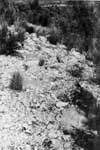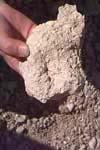|
Introduction From about 8 million to about 2 million years ago during the Pliocene-Pleistocene period, the central Verde valley had a rich history in the deposition of over 3000 feet of sediments in a lacustrine (lake) type environment. The area includes Camp Verde, Clarkdale, Cottonwood, Page Springs to Cornville, and finally near Jerome. The depositional event started when a large lava flow near Childs dammed the Verde River, and created a huge basin for a large saline and muddy lake. The Verde Formation as it is called includes limestones, mudstones, evaporites, and barely lithified sandstones over various areas. The steep layered cliffs visible near the Highway I-17 near Camp Verde is the eroded remanents of the Verde Formation, as well as the white limestones at Montezumas Well. Deposited within the same time frame are the Payson, Tonto and San Carlos Basins furthur south east. The climate at the time of deposition was not unlike Africa's grassy savannas today, complete with camels, mastodons, tapirs, and large cats. Fossil evidence is rare, however beyond the fossil trackways of these large animals, we also find large numbers of turriculate form gastropods, ostracods, and countless impressions of aquatic plants similar to cattails and reeds. We have also encountered blocks of limestone with rodent or bat bones, carbonized plant beds, and other small fossils of enigmatic origin. Near the deepest part of the ancient lake bed we find a selection of evaporite minerals near Camp Verde down Salt Mine Road. The old abandoned salt mine was mined thousands of years ago by the local Sinagua Indians, and contains some unique minerals found few other places. While massive halite (salt) can be found in abundance here, we also have collected fine specimens of glauberite, thenaradite, and a complete series of pseudomorphs after glauberite including gypsum, calcite and selenite. In 1962 F. R. Twenter of the USGS published a paper on new fossil localities in the Verde Formation, the results of over a decade of field work. This monumental work has not been equaled since, and as a part of our study to more complete our knowledge of this formation, we have spent many hundreds of hours in the field re-examining the original Twenter sites and documenting our observations. We have found that the Verde formation contains some of the most beautiful landscapes and scenery in all of Arizona, and it was a true pleasure to explore it. General images of the Verde Formation Click on the image title for an enlarged view. Files average 50k in size.
Both bedded and slope forming deposits are typical of the Verde Formation near Clarkdale. The Verde is almost always thin bedded and interbedded with softer marls and mudstones. Close up of the previous ridge showing more detail in the typical Verde Formation outcrop. The resistant bedded limestones give way to the slope forming softer marls. Note also the gap between the two thicker beds, it is filled with a recessed softer marl as well that has eroded away at the surface Another fine example near Clarkdale of bedded and slope forming deposits of the Verde formation. On this ridge, numerous Indian ruins and dwelling were made from cavities in the cliff face from the Sinaguas. A wash near Twenter site 6 near Cottonwood shows how the soft marls of the Verde can be easily cut down by water flow for form some spectacular scenery. Nearly all the boulders in the creek bottom were fossiliferous with gastropods and ostracods as molds in the rocks. Vince Mele stands on outcrop, over a steep 20 foot waterfall area. Large camel trackways visible in the shadows in a flat near a creek near Camp Verde. The impressions are weak and shallow here, but an infilling of darker sand makes them stand out clearly. It so hard to imagine 5 million years ago a heard of camels moved through here. The following year, the river overflowed, completely erasing all traces of the imprints. Superb imprint of a camel (?) track showing the fossil mud squishing out on the sides of the imprint. The size of the track is about four inches, and such preservation in solid limey marl is extremely exceptional. Camp Verde Area. Dawn and Leszek make plaster cast of camel tracks in the Verde Formation near Camp Verde. This is an excellent way to preserve the rare trackways without disturbing them in the formational unit they occur. Beautifully preserved hoofed trackways in limey marl in Verde Formation. These Pleistocene tracks mark a single day millions of years ago when a heard of animals moved through here. My footprint in the overlying sand is just under the brush. These are some of the best preserved tracks we have ever found in this formation. Another fine group of tracks in the Camp Verde area in the same type of limy marls. Both manus and pes (front and rear foot) imprints of this camel like animal, which were about four inches long each were preserved in excellent detail. This is the group we made the plaster casts of. Following the footsteps of F. R. Twenter Twenter Site 26 The light tan dolomites and mudstones of this site contained a rich faunal assemblage of inch long gastropods, plant hash, and ostracods. Dawn is at the top and our friend Leszek are defining the extents of the fossiliferous bed here, just moments after we found it. Typical ledge forming mudstones yield a series of dolomite interbeds with a fetid (petroleum like) odor when struck with a hammer. These fetid dolomites were filled with countless freshwater gastropods, both coiled and turriculate in form. Leszek is working the underside of a ledge for specimens with the best preservation. Although the limestones were not as rich as the dolomites in fossils, the preservation in three dimensions of the enclosed fossils was better. Many of the specimens found in the limestones had at least some original shell material. Block of mudstone with large numbers of rodent bones within. The block is about two feet wide, and the bones averaged 2 to 3mm in diameter, some being clearly more hollow than others causing Twenter to speculate on a bat origin. Twenter Site 33 (Elephant Hill) Trackway of half a dozen dinner plate sized prints at the site. This was part of a Mesa Southwest Museum sponsored expedition me and Dawn led to documents and measure the locations and properties of the track types. These here are from Stegomastadons some 2- 6 My ago. Dawns foot next to a baby mastodon footprint. Several smaller animals had parallel tracks to the larger mastodons, such as a mother leading her young might leave. The preservation is poor do to crumbling marls, and the site is protected by the park service from entering without permission. Twenter Site 4 This site, at the bottom of a deep wash is good evidence of a low diversity carbonate mud environment at the bottom of a warm lake. Muddy conditions or high salinity certainly contributed to the low diversity in the gastropod fauna found here, one one species was found, but in great numbers. Dawn and our paleo buddy Steve Fowers examine a rich gastropod coquina under a ledge in the creek bottom. A part of the rich gastropod coquina found at this site. Most are molds of sizes ranging from a few millimeters to up to an inch. This site was also noted for the small size of the specimens, perhaps relating to crowded conditions or diminishing food supply. Twenter Site 6 An excellent example of fossil cattails. Down in this creek bottom site, large blocks of a travertine like limestone contained unbelievable amounts of plant hash, the fossil reeds had clear impressions of external ribbing and stem attachment points. About half were in growth position, and the rest were laid down flat like a flood had matted them before burial. Thin lenses of a coal like carbonaceous bed were found here, and close examination revealed carbonized leaf fragments, and stems or roots. Carbonaceous beds in the Verde formation are quite rare, and should be examined carefully. Hordes of fossil reeds and cattails in the Pleistocene sediments. This large block was part of a long ledge several feet thick and hundreds of feet long with clear impressions of ribbed stems and roots. Twenter Site 8 Low gastropod diversity again at this lacustrine deposit at a uranium prospect pit. The whole area was virtually painted yellow with what the prospectors surmised was carnotite, a poor grade uranium ore. We tested the area with geiger counters, and no radiation was found. A coating of a yellow clay was apparently the cause. Cracking the rocks here yielded molds of inch long gastropods and ostracods (shrimp like arthropods,with clam like shells). Many times a yellow powder (NOT radioactive!) dumped out of the molds. Parked at Twenter site 8 with the Jeep. Many of the soft marls form rounded hills in the Verde Formation, unlike some of the other sites with hard resistant dolomites that form water carved cliffs. |






















